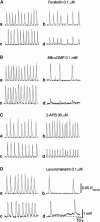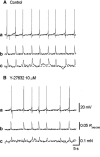Correlation between spontaneous electrical, calcium and mechanical activity in detrusor smooth muscle of the guinea-pig bladder
- PMID: 14662721
- PMCID: PMC1574183
- DOI: 10.1038/sj.bjp.0705602
Correlation between spontaneous electrical, calcium and mechanical activity in detrusor smooth muscle of the guinea-pig bladder
Abstract
1. To investigate the cellular mechanisms underlying spontaneous excitation of smooth muscle of the guinea-pig urinary bladder, isometric tension was measured in muscle bundles while recording the membrane potential from a cell in the bundle with a microeletrode. Changes in the intracellular calcium concentration ([Ca(2+)](i); calcium transients) were recorded in strips loaded with the fluorescent dye, fura-PE3. 2. In 40% of preparations, individual action potentials and contractions, which were abolished by nifedipine (1 microm), were generated. In the remaining preparations, bursting action potentials and contractions were generated. Contractions were again abolished by nifedipine (1 microm), while higher concentrations of nifedipine (10-30 microm) were required to prevent the electrical activity. 3. Carbachol (0.1 microm) increased the frequency of action potentials and corresponding contractions. Apamin (0.1 microm) potentiated bursting activity and enhanced phasic contraction. Charybdotoxin (CTX, 50 nm) induced prolonged action potentials that generated enlarged contractions. In contrast, levcromakalim (0.1 microm) reduced the frequency of action potentials, action potential bursts and the size of the contractions. 4. Forskolin (0.1 microm), 8-bromoguanosin 3', 5' cyclic monophosphate (8Br-cGMP, 0.1 mm) and Y-26763 (10 microm) suppressed contractions without reducing the amplitude of either action potentials or Ca transients. 5. This paper confirms that action potentials and associated calcium transients are fundamental mechanisms in generating spontaneous contractions in smooth muscles of the guinea-pig bladder. However, in parallel with the excitation-contraction coupling, the sensitivity of the contractile proteins for Ca(2+) may play an important role in regulating spontaneous excitation and can be modulated by cyclic nucleotides and Rho kinase.
Figures








References
-
- ANDERSSON K.-E., HOLMQUIST F., FOVAEUS M., HEDLUND H., SUNDLER R. Muscarinic receptor stimulation of phosphoinositide hydrolysis in the human isolated urinary bladder. J. Urol. 1991;146:1156–1159. - PubMed
-
- ASCHER-LANDSBERG J., SAUNDERS T., ELOVITZ M., PHILLIPPE M. The effects of 2-aminoethoxydiphenyl borate, a novel inositol 1,4,5-trisphosphate receptor modulator on myometrial contractions. Biochem. Biophys. Res. Commun. 1999;264:979–982. - PubMed
-
- BRADING A.F., TURNER W.H. The unstable bladder: towards a common mechanism. Br. J. Urol. 1994;73:3–8. - PubMed
Publication types
MeSH terms
Substances
LinkOut - more resources
Full Text Sources
Miscellaneous

